1.排序算法

1.1 插入排序
//插入排序
public static void InsertionSort(int[] dataArray)
{
for (int i = 1; i < dataArray.Length; i++)
{
for (int j = i; j > 0; j--)
{
if (dataArray[j] < dataArray[j - 1])
{
int temp = dataArray[j];
dataArray[j] = dataArray[j - 1];
dataArray[j - 1] = temp;
}
else
{
break;
}
}
}
}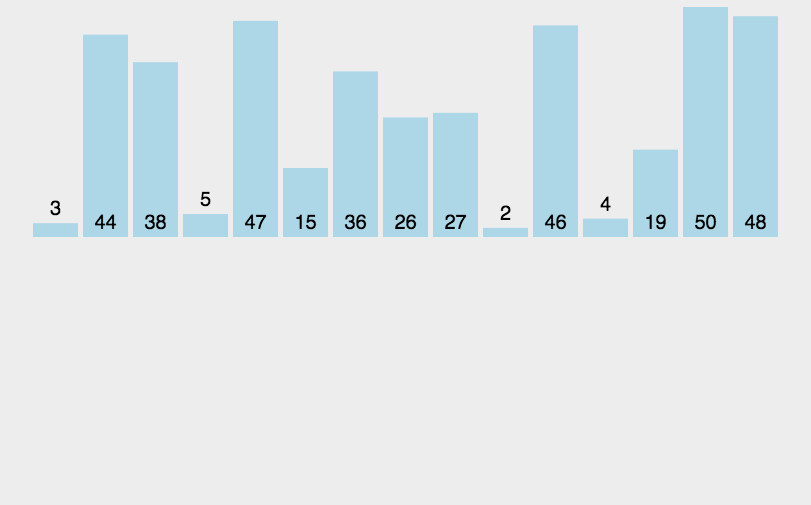
1.2 选择排序
//选择排序
public static void SelectionSort(int[] dataArray)
{
for (int i = 0; i < dataArray.Length; i++)
{
for (int j = i + 1; j < dataArray.Length; j++)
{
if (dataArray[i] > dataArray[j])
{
int temp = dataArray[i];
dataArray[i] = dataArray[j];
dataArray[j] = temp;
}
}
}
}
每次选一个最小的
1.3 冒泡排序
//冒泡排序
public static void BubbleSort(int[] dataArray)
{
for (int i = 0; i < dataArray.Length; i++)
{
bool flag = true;
for (int j = 0; j < dataArray.Length - i - 1; j++)
{
if (dataArray[j] > dataArray[j + 1])
{
int temp = dataArray[j];
dataArray[j] = dataArray[j + 1];
dataArray[j + 1] = temp;
flag = false;
}
}
if (flag)
{
break;
}
}
}
1.4 希尔排序(分组插入排序)
间隔d = n,然后无限除以2
public void shellsort(int[]a)
{
int d = a.Length / 2;
while(d>=1)
{
// 由于间隔d,故从0-d开始遍历一遍就全遍历了
for(int i=0;i<d;i++)
{
// 遍历的时候,加一次就加d
for(int j=i+d;j<a.Length;j+=d)
{
int temp=a[j];//存储和其比较的上一个a[x];
int loc = j;
//间隔d的插入排序
while (loc - d >= i&&temp < a[loc - d])//&&j-d>=i
{
a[loc] = a[loc - d];
loc = loc - d;
}
a[loc] = temp;
}
}
//一次插入排序结束,d缩小一半
d = d / 2;
}
}操作步骤:
初始时,有一个大小为 10 的无序序列。(N = 10)
- 在第一趟排序中,令增量d = N / 2 = 5,(貌似都是从缩小一半开始)即相隔距离为 5 的元素组成一组,可以分为 5 组。
- 按照直接插入排序的方法对每个组进行排序。
- 在第二趟排序中,我们把上次的 d 缩小一半,即 d= d / 2 = 2 (取整数)。这样每相隔距离为 2 的元素组成一组,可以分为 2 组。
- 按照直接插入排序的方法对每个组进行排序。
- 在第三趟排序中,再次把 d 缩小一半,即d = d / 2 = 1。 这样相隔距离为 1 的元素组成一组,即只有一组。
- 按照直接插入排序的方法对每个组进行排序。此时,排序已经结束。
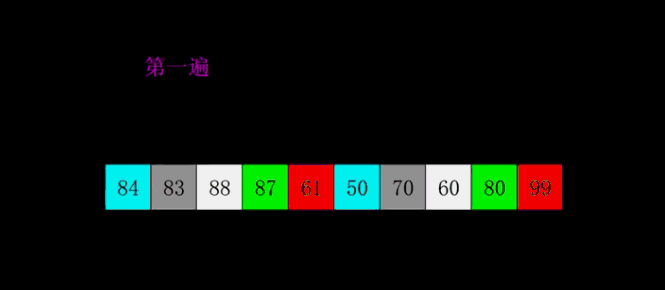
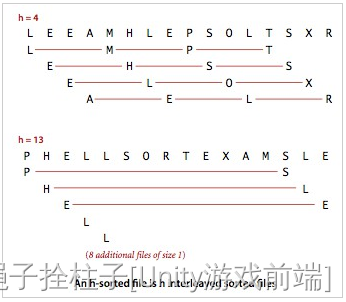
1.5 快速排序(需要默写)
- 首先设定一个分界值,通过该分界值将数组分成左右两部分
- 右边部分的所以值大于分解值 左边部分的所以值小于分界值
- 接着左右两边分开,分别做快排
void add(int a[10],int left,int right)
{
int l=left;
int r=right;
int x=a[left];
while(r>l)
{
if(r>=l&&a[r]>=x)
r--;
a[l]=a[r];
if(r>=l&&a[l]<=x)
l++;
a[r]=a[l];
}
a[r]=x;
}
int main(int argc, char *argv[])
{
int a[10]={4,3,6,1,8,0,3,2,5,7};
add(a,0,9);
int i;
for(i=0;i<10;i++)
{
// printf("%d\t",a[i]);
Console.WriteLine(a[i]);
}
return 0;
}
1.6 归并排序(需要默写)
算法描述 - 把长度为n的输入序列分成两个长度为n/2的子序列;
- -对这两个子序列分别采用归并排序;
- -将两个排序好的子序列合并成一个最终的排序序列。
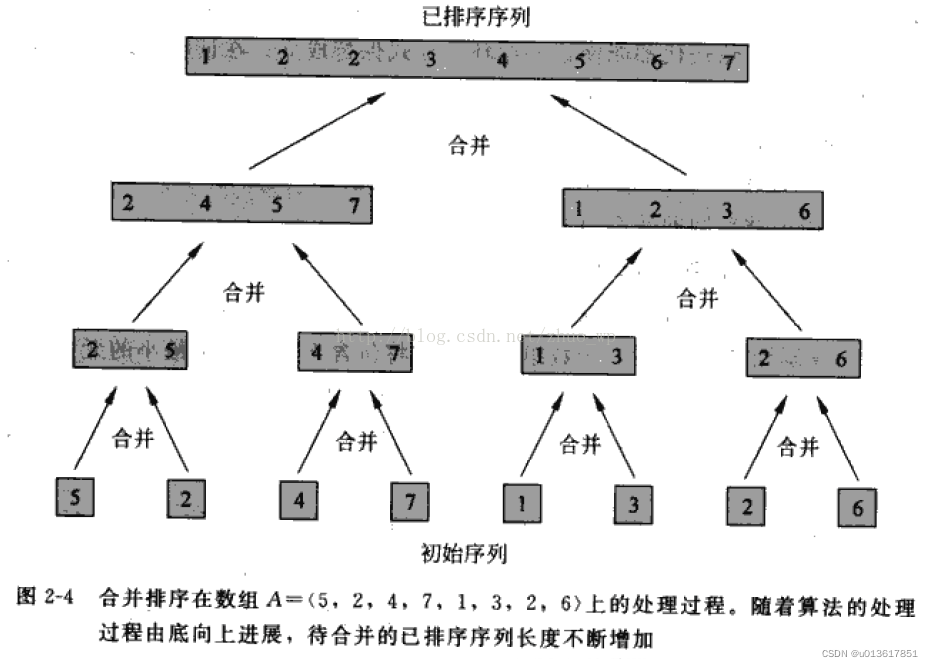
//给外面的接口
public static void MergeSort(int[] array)
{
MergeSort(array, 0, array.Length - 1);
}
//给自己的递归接口
private static void MergeSort(int[] array, int p, int r)
{
if (p < r)
{
int q = (p + r) / 2;
MergeSort(array, p, q);
MergeSort(array, q + 1, r);
Merge(array, p, q, r);
}
}
//合并两个有序列表
private static void Merge(int[] array, int p, int q, int r)
{
int[] L = new int[q - p + 2];
int[] R = new int[r - q + 1];
L[q - p + 1] = int.MaxValue;
R[r - q] = int.MaxValue;
for (int i = 0; i < q - p + 1; i++)
{
L[i] = array[p + i];
}
for (int i = 0; i < r - q; i++)
{
R[i] = array[q + 1 + i];
}
int j = 0;
int k = 0;
for (int i = 0; i < r - p + 1; i++)
{
if (L[j] <= R[k])
{
array[p + i] = L[j];
j++;
}
else
{
array[p + i] = R[k];
k++;
}
}
}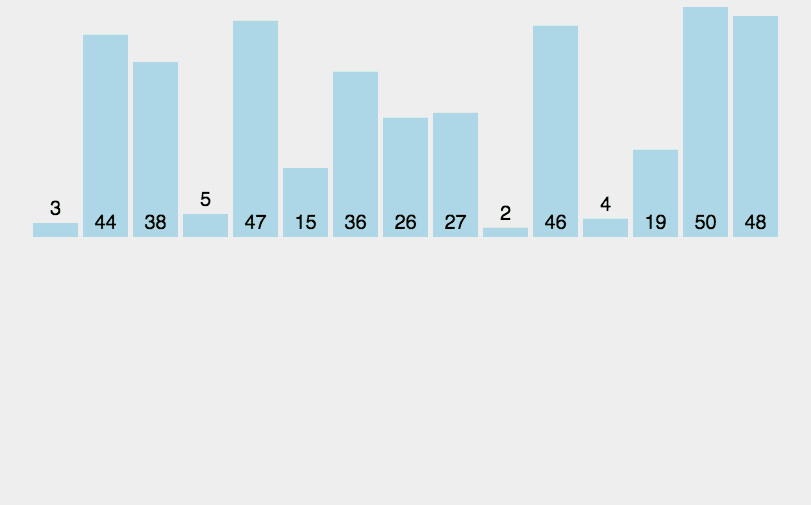
1.7 堆排序(Heap Sort 需要默写)
堆排序(Heapsort)是指利用堆这种数据结构所设计的一种排序算法。堆是一个近似完全二叉树的结构,并同时满足堆积的性质:即子结点的键值或索引总是小于(或者大于)它的父节点。
算法描述
- 将初始待排序关键字序列(R1,R2….Rn)构建成大顶堆,此堆为初始的无序区;
- 将堆顶元素R[1]与最后一个元素R[n]交换,此时得到新的无序区(R1,R2,……Rn-1)和新的有序区(Rn),且满足R[1,2…n-1]<=R[n];
- 由于交换后新的堆顶R[1]可能违反堆的性质,因此需要对当前无序区(R1,R2,……Rn-1)调整为新堆,然后再次将R[1]与无序区最后一个元素交换,得到新的无序区(R1,R2….Rn-2)和新的有序区(Rn-1,Rn)。不断重复此过程直到有序区的元素个数为n-1,则整个排序过程完成。
/*
* 堆排序是一种选择排序,时间复杂度为O(nlog<sub>2</sub>n)。
*
* 堆排序的特点是:
* 在排序过程中,将待排序数组看成是一棵完全二叉树的顺序存储结构,
* 利用完全二叉树中父结点和子结点之间的内在关系,在当前无序区中选择关键字最大(或最小)的记录。
*
* 基本思想
* 1.将待排序数组调整为一个大根堆。大根堆的堆顶元素就是这个堆中最大的元素。
* 2.将大根堆的堆顶元素和无序区最后一个元素交换,并将无序区最后一个位置列入有序区,然后将新的无序区调整为大根堆。
* 3.重复操作,直到无序区消失为止。
* 初始时,整个数组为无序区。每一次交换,都是将大根堆的堆顶元素换入有序区,以保证有序区是有序的。
*/
namespace HeapSort
{
using System;
/// <summary>
/// The program.
/// </summary>
public static class Program
{
/// <summary>
/// 程序入口点。
/// </summary>
public static void Main()
{
int[] a = {1, 14, 6, 2, 8, 66, 9, 3, 0, 10, 5, 34, 76, 809, 4, 7};
Console.WriteLine("Before Heap Sort:");
foreach (int i in a)
{
Console.Write(i + " ");
}
Console.WriteLine("\r\n");
Console.WriteLine("In Heap Sort:");
HeapSort(a);
Console.WriteLine("");
Console.WriteLine("After Heap Sort:");
foreach (int i in a)
{
Console.Write(i + " ");
}
}
/// <summary>
/// 堆排序方法。
/// </summary>
/// <param name="a">
/// 待排序数组。
/// </param>
private static void HeapSort(int[] a)
{
// 建立大根堆。
BuildMaxHeap(a);
Console.WriteLine("Build max heap:");
foreach (int i in a)
{
// 打印大根堆。
Console.Write(i + " ");
}
Console.WriteLine("\r\nMax heap in each heap sort iteration:");
for (int i = a.Length - 1; i > 0; i--)
{
// 将堆顶元素和无序区的最后一个元素交换。
Swap(ref a[0], ref a[i]);
// 将新的无序区调整为大根堆。
MaxHeaping(a, 0, i);
// 打印每一次堆排序迭代后的大根堆。
for (int j = 0; j < i; j++)
{
Console.Write(a[j] + " ");
}
Console.WriteLine(string.Empty);
}
}
/// <summary>
/// 由底向上建堆。
/// 由完全二叉树的性质可知,叶子结点是从index=a.Length/2开始,
/// 所以从index=(a.Length/2)-1结点开始由底向上进行大根堆的调整。
/// </summary>
/// <param name="a">
/// 待排序数组。
/// </param>
private static void BuildMaxHeap(int[] a)
{
for (int i = (a.Length / 2) - 1; i >= 0; i--)
{
MaxHeaping(a, i, a.Length);
}
}
/// <summary>
/// 将指定的结点调整为堆。
/// </summary>
/// <param name="a">
/// 待排序数组。
/// </param>
/// <param name="i">
/// 需要调整的结点。
/// </param>
/// <param name="heapSize">
/// 堆的大小,也指数组中无序区的长度。
/// </param>
private static void MaxHeaping(int[] a, int i, int heapSize)
{
// 左子结点。
int left = (2 * i) + 1;
// 右子结点。
int right = 2 * (i + 1);
// 临时变量,存放大的结点值。
int large = i;
// 比较左子结点。
if (left < heapSize && a[left] > a[large])
{
large = left;
}
// 比较右子结点。
if (right < heapSize && a[right] > a[large])
{
large = right;
}
// 如有子结点大于自身就交换,使大的元素上移;并且把该大的元素调整为堆以保证堆的性质。
if (i != large)
{
Swap(ref a[i], ref a[large]);
MaxHeaping(a, large, heapSize);
}
}
/// <summary>
/// 交换两个整数的值。
/// </summary>
/// <param name="a">整数a。</param>
/// <param name="b">整数b。</param>
private static void Swap(ref int a, ref int b)
{
int tmp = a;
a = b;
b = tmp;
}
}
}
// Output:
/*
Before Heap Sort:
1 14 6 2 8 66 9 3 0 10 5 34 76 809 4 7
In Heap Sort:
Build max heap:
809 14 76 7 10 66 9 3 0 8 5 34 1 6 4 2
Max heap in each heap sort iteration:
76 14 66 7 10 34 9 3 0 8 5 2 1 6 4
66 14 34 7 10 4 9 3 0 8 5 2 1 6
34 14 9 7 10 4 6 3 0 8 5 2 1
14 10 9 7 8 4 6 3 0 1 5 2
10 8 9 7 5 4 6 3 0 1 2
9 8 6 7 5 4 2 3 0 1
8 7 6 3 5 4 2 1 0
7 5 6 3 0 4 2 1
6 5 4 3 0 1 2
5 3 4 2 0 1
4 3 1 2 0
3 2 1 0
2 0 1
1 0
0
After Heap Sort:
0 1 2 3 4 5 6 7 8 9 10 14 34 66 76 809
*/1.8 基数排序(Radix Sort)
基数排序属于“分配式排序”(Distribution Sort),它是透过键值的部份信息,将要排序的元素分配至某些“桶”中,藉以达到排序的作用。基数排序法是属于稳定性的排序,其时间复杂度为 O (n*log(r)*m) 。其中r为所采取的基数,而m为堆数,在某些时候,基数排序法的效率高于其它的稳定性排序法。(可以理解为,先按个位分配到哈希表中,这样他们个位就有顺序了,再按十位分配到哈希表,再按百位,按千位)
public int[] RadixSort2(int[] array)
{
//求最(大)值
int max = array[0];
foreach (var item in array)
{
max = item > max ? item : max;
}
int maxDigit = 0;
while(max!=0)
{
max /= 10;maxDigit++;
}
//初新桶
var bucket = new List<List<int>>();
for (int i = 0; i < 10; i++)
{
bucket.Add(new List<int>());
}
// 先按个位平铺并比较各自的大小,这样个位顺序就是正确的了,再按十位,再按百位
for (int i = 0; i < maxDigit; i++)
{
//正填充,div用来下面构成“个十百千.....位”
int div = (int)Math.Pow(10, (i + 1));
foreach (var item in array)
{
//获取基数 获取数的第几位数字
int radix = (item % div) / (div / 10);
//这一位,比如十位,添加好整个排好序的数列。
bucket[radix].Add(item);
}
//反填充(个位已经按顺序铺好了,就按个位ok的顺序弄回array)
int index = 0;
foreach (var item in bucket)
{
foreach (var it in item)
{
array[index++] = it;
}
item.Clear();//清除数据
}
}
return array;
}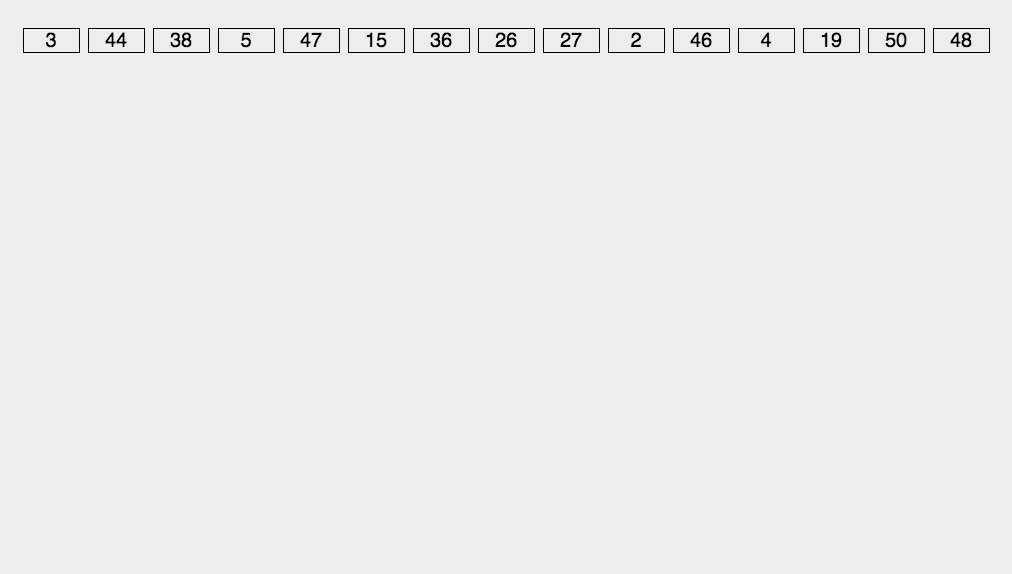
2.查找算法
2.1 二分查找
基本思想:元素必须是有序的,属于有序查找算法。
注:折半查找的前提条件是需要有序表顺序存储,对于静态查找表,一次排序后不再变化,折半查找能得到不错的效率。但对于需要频繁执行插入或删除操作的数据集来说,维护有序的排序会带来不小的工作量,那就不建议使用。
public static int BinarySearch(int[] arr, int low, int high, int key)
{
int mid = (low + high) / 2;
if (low > high)
return -1;
else
{
if (arr[mid] == key)
return mid;
else if (arr[mid] > key)
return BinarySearch(arr, low, mid - 1, key);
else
return BinarySearch(arr, mid + 1, high, key);
}
}其中位运算,mid = (low + hi) >> 1;相当于mid = (low + hi) / 2;
相比于除法运算,位运算更快。
2.2 插值查找
基本思想:插值查找,是对二分法查找的优化,插值优化了mid,使之更接近查找数值在有序序列的实际位置,也是有序查找。
/// <summary>
/// 插值查找,是对二分法查找的优化
/// 二分法: mid = low + 1/2 *(high - low)
/// 插值查找:mid = low + ((point-array[low])/(array[high]-array[low]))*(high-low)
/// 插值优化了mid,使之更接近查找数值在有序序列的实际位置
/// </summary>
/// <param name="arr"></param>
/// <param name="low"></param>
/// <param name="height"></param>
/// <param name="value"></param>
/// <returns></returns>
private static int InterpolationSearch(int[] arr, int low, int height, int value)
{
if (arr == null || arr.Length == 0 || low >= height)
{
return -1;
}
int hi = height - 1;
int lowValue = arr[low];
int heightValue = arr[hi];
if (lowValue > value || value > heightValue)
{
return -1;
}
int mid;
while (low <= hi)
{
// 主要是这行做了特殊处理,不直接找中间,而是按比例找一个数
mid = low + ((value - lowValue) / (heightValue - lowValue)) * (hi - low);
int item = arr[mid];
if (item == value)
{
return mid;
}
else if (item > value)
{
hi = mid - 1;
}
else
{
low = mid + 1;
}
}
return -1;
}2.3 斐波那契查找
基本思想:在二分查找的基础上根据斐波那契数列进行分割的。
/// <summary>
/// 斐波那契查找就是在二分查找的基础上根据斐波那契数列进行分割的。
/// 在斐波那契数列找一个等于略大于查找表中元素个数的数F[n],
/// 将原查找表扩展为长度为F[n](如果要补充元素,则补充重复最后一个元素,直到满足F[n]个元素),
/// 完成后进行斐波那契分割,即F[n]个元素分割为前半部分F[n-1]个元素,后半部分F[n-2]个元素,
/// 那么前半段元素个数和整个有序表长度的比值就接近黄金比值0.618,
/// 找出要查找的元素在那一部分并递归,直到找到。
/// middle = low + fb[k - 1] - 1
/// </summary>
private static int FbSearch(int[] arr, int value)
{
if (arr == null || arr.Length == 0)
{
return -1;
}
int length = arr.Length;
// 创建一个长度为20的斐波数列 1 1 2 3 5 8 ....
int[] fb = MakeFbArray(20);
int k = 0;
//从左向右滑动,滑动到临界点
while (length > fb[k] - 1)
{
// 找出数组的长度在斐波数列(减1)中的位置,将决定如何拆分
k++;
}
// 满足黄金比例分割
if (length == fb[k - 1])
{
return FindFbSearch(arr, fb, --k, value, length);
}
else
{
// 构造一个长度为fb[k] - 1的新数列,就是扩建原数组到斐波那契长度
int[] temp = new int[fb[k] - 1];
// 把原数组拷贝到新的数组中
arr.CopyTo(temp, 0);
int tempLen = temp.Length;
for (int i = length; i < tempLen; i++)
{
// 从原数组长度的索引开始,用最大的值补齐新数列
temp[i] = arr[length - 1];
}
//从扩建好的数组中进行斐波那契查找查找
return FindFbSearch(temp, fb, k, value, length);
}
}
private static int FindFbSearch(int[] arr, int[] fb, int k, int value, int length)
{
int low = 0;
int hight = length - 1;
while (low <= hight)
{
// 黄金比例分割点
int middle = low + fb[k - 1] - 1;
if (arr[middle] > value)
{
hight = middle - 1;
// 全部元素 = 前半部分 + 后半部分
// 根据斐波那契数列进行分割,F(n)=F(n-1)+F(n-2)
// 因为前半部分有F(n-1)个元素,F(n-1)=F(n-2)+F(n-3),
// 为了得到前半部分的黄金分割点n-2,
// int middle = low + fb[k - 1] - 1; k已经减1了
// 所以k = k - 1
k = k - 1;
}
else if (arr[middle] < value)
{
low = middle + 1;
// 全部元素 = 前半部分 + 后半部分
// 根据斐波那契数列进行分割,F(n)=F(n-1)+F(n-2)
// 因为后半部分有F(n-2)个元素,F(n-2)=F(n-3)+F(n-4),
// 为了得到后半部分的黄金分割点n-3,
// int middle = low + fb[k - 1] - 1; k已经减1了
// 所以k = k - 2
k = k - 2;
}
else
{
if (middle <= hight)
{
return middle;// 若相等则说明mid即为查找到的位置
}
else
{
return hight;// middle的值已经大于hight,进入扩展数组的填充部分,即原数组最后一个数就是要查找的数
}
}
}
return -1;
}
// 构建斐波那契数列 1 1 2 3 5 8 ....
public static int[] MakeFbArray(int length)
{
int[] array = null;
if (length > 2)
{
array = new int[length];
array[0] = 1;
array[1] = 1;
for (int i = 2; i < length; i++)
{
array[i] = array[i - 1] + array[i - 2];
}
}
return array;
}2.4 分块查找
public struct IndexBlock
{
public int max;
public int start;
public int end;
};
const int BLOCK_COUNT = 3;
private static void InitBlockSearch()
{
int j = -1;
int k = 0;
int[] a = new int[] { 1, 2, 3, 4, 5, 6, 7, 8, 9, 10, 11, 12, 13, 14, 15 };
IndexBlock[] indexBlock = new IndexBlock[BLOCK_COUNT];
for (int i = 0; i < BLOCK_COUNT; i++)
{
indexBlock[i].start = j + 1; //确定每个块范围的起始值
j = j + 1;
indexBlock[i].end = j + 4; //确定每个块范围的结束值
j = j + 4;
indexBlock[i].max = a[j]; //确定每个块范围中元素的最大值
}
k = BlockSearch(12, a, indexBlock);
if (k >= 0)
{
Console.WriteLine("查找成功!你要查找的数在数组中的索引是:{0}\n", k);
}
else
{
Console.WriteLine("查找失败!你要查找的数不在数组中。\n");
}
}
/// <summary>
/// 分块查找
/// 分块查找要求把一个数据分为若干块,每一块里面的元素可以是无序的,但是块与块之间的元素需要是有序的。
/// (对于一个非递减的数列来说,第i块中的每个元素一定比第i-1块中的任意元素大)
/// </summary>
private static int BlockSearch(int x, int[] a, IndexBlock[] indexBlock)
{
int i = 0;
int j;
while (i < BLOCK_COUNT && x > indexBlock[i].max)
{
//确定在哪个块中
i++;
}
if (i >= BLOCK_COUNT)
{
//大于分的块数,则返回-1,找不到该数
return -1;
}
//j等于块范围的起始值
j = indexBlock[i].start;
while (j <= indexBlock[i].end && a[j] != x)
{
//在确定的块内进行查找
j++;
}
if (j > indexBlock[i].end)
{
//如果大于块范围的结束值,则说明没有要查找的数,j置为-1
j = -1;
}
return j;
}2.5 最简单的树表查找算法——二叉树查找算法
基本思想:二叉查找树是先对待查找的数据进行生成树,确保树的左分支的值小于右分支的值,然后在就行和每个节点的父节点比较大小,查找最适合的范围。
二叉树的性质:
1)若任意节点的左子树不空,则左子树上所有结点的值均小于它的根结点的值;
2)若任意节点的右子树不空,则右子树上所有结点的值均大于它的根结点的值;
3)任意节点的左、右子树也分别为二叉查找树。
using System;
using System.Collections.Generic;
namespace StructScript
{
public class BinaryTree<T>
{
//根节点
private TreeNode<T> mRoot;
//比较器
private Comparer<T> mComparer;
public BinaryTree()
{
mRoot = null;
mComparer = Comparer<T>.Default;
}
public bool Contains(T value)
{
if (value == null)
{
throw new ArgumentNullException();
}
TreeNode<T> node = mRoot;
while (node != null)
{
int comparer = mComparer.Compare(value, node.Data);
if (comparer > 0)
{
node = node.RightChild;
}
else if (comparer < 0)
{
node = node.LeftChild;
}
else
{
return true;
}
}
return false;
}
public void Add(T value)
{
mRoot = Insert(mRoot, value);
}
private TreeNode<T> Insert(TreeNode<T> node, T value)
{
if (node == null)
{
return new TreeNode<T>(value, 1);
}
int comparer = mComparer.Compare(value, node.Data);
if (comparer > 0)
{
node.RightChild = Insert(node.RightChild, value);
}
else if (comparer < 0)
{
node.LeftChild = Insert(node.LeftChild, value);
}
else
{
node.Data = value;
}
return node;
}
public int Count
{
get
{
return CountLeafNode(mRoot);
}
}
private int CountLeafNode(TreeNode<T> root)
{
if (root == null)
{
return 0;
}
else
{
return CountLeafNode(root.LeftChild) + CountLeafNode(root.RightChild) + 1;
}
}
public int Depth
{
get
{
return GetHeight(mRoot);
}
}
private int GetHeight(TreeNode<T> root)
{
if (root == null)
{
return 0;
}
int leftHight = GetHeight(root.LeftChild);
int rightHight = GetHeight(root.RightChild);
return leftHight > rightHight ? leftHight + 1 : rightHight + 1;
}
public T Max
{
get
{
TreeNode<T> node = mRoot;
while (node.RightChild != null)
{
node = node.RightChild;
}
return node.Data;
}
}
public T Min
{
get
{
if (mRoot != null)
{
TreeNode<T> node = GetMinNode(mRoot);
return node.Data;
}
else
{
return default(T);
}
}
}
public void DelMin()
{
mRoot = DelMin(mRoot);
}
private TreeNode<T> DelMin(TreeNode<T> node)
{
if (node.LeftChild == null)
{
return node.RightChild;
}
node.LeftChild = DelMin(node.LeftChild);
return node;
}
public void Remove(T value)
{
mRoot = Delete(mRoot, value);
}
private TreeNode<T> Delete(TreeNode<T> node, T value)
{
if (node == null)
{
Console.WriteLine("没有找到要删除的节点: " + value);
return null;
}
int comparer = mComparer.Compare(value, node.Data);
if (comparer > 0)
{
node.RightChild = Delete(node.RightChild, value);
}
else if (comparer < 0)
{
node.LeftChild = Delete(node.LeftChild, value);
}
else
{
// 1.如果删除节点没有子节点,直接返回null
// 2.如果只有一个子节点,返回其子节点代替删除节点即可
if (node.LeftChild == null)
{
return node.RightChild;
}
else if (node.RightChild == null)
{
return node.LeftChild;
}
else
{
// 3.当左右子节点都不为空时
// 找到其右子树中的最小节点,替换删除节点的位置
TreeNode<T> tempNode = node;
node = GetMinNode(tempNode.RightChild);
node.RightChild = DelMin(tempNode.RightChild);
node.LeftChild = tempNode.LeftChild;
}
}
return node;
}
private TreeNode<T> GetMinNode(TreeNode<T> node)
{
while (node.LeftChild != null)
{
node = node.LeftChild;
}
return node;
}
// 中序遍历:首先遍历其左子树,然后访问根结点,最后遍历其右子树。
// 递归方法实现体内再次调用方法本身的本质是多个方法的简写,递归一定要有出口
public void ShowTree()
{
ShowTree(mRoot);
}
private void ShowTree(TreeNode<T> node)
{
if (node == null)
{
return;
}
ShowTree(node.LeftChild);
//打印节点数据
Console.WriteLine(node.Data);
ShowTree(node.RightChild);
}
}
public class TreeNode<T>
{
//数据
public T Data { get; set; }
//左孩子
public TreeNode<T> LeftChild { get; set; }
//右孩子
public TreeNode<T> RightChild { get; set; }
public TreeNode(T value, int count)
{
Data = value;
LeftChild = null;
RightChild = null;
}
}
}二叉树的查找:
将要查找的value和节点的value比较,如果小于,那么就在Left Node节点查找;如果大于,则在Right Node节点查找,如果相等,更新Value。
二叉树的删除:
- 如果删除节点没有子节点,直接删除这个节点。
- 如果只有一个子节点,删除节点,并把其子节点代替删除节点。
- 当左右子节点都不为空时,删除节点,并找到其右子树中的最小节点(树两边的中间值),替换删除节点的位置。
二叉树的增加:
如果比本身节点大,则给右子树增加这个值,如果比本身节点小,则给左子树增加这个值,以此递归。
2.6 树表查找算法——红黑树
2.7 树表查找算法——B树和B+树
B树,概括来说是一个节点可以拥有多于2个子节点的二叉查找树。与自平衡二叉查找树不同,B树为系统最优化大块数据的读和写操作。B-tree算法减少定位记录时所经历的中间过程,从而加快存取速度。普遍运用在数据库和文件系统。
B树定义:
B树可以看作是对2-3查找树的一种扩展,即他允许每个节点有M-1个子节点。
- 根节点至少有两个子节点
- 每个节点有M-1个key,并且以升序排列
- 位于M-1和M key的子节点的值位于M-1 和M key对应的Value之间
- 其它节点至少有M/2个子节点
B+树定义:
B+树是对B树的一种变形树,它与B树的差异在于:
- 有k个子结点的结点必然有k个关键码;
- 非叶结点仅具有索引作用,跟记录有关的信息均存放在叶结点中。
- 树的所有叶结点构成一个有序链表,可以按照关键码排序的次序遍历全部记录。
2.8 树表查找算法——2-3查找树
2-3查找树的定义如下:
- 要么为空,要么:
- 2节点,该节点保存一个key及对应value,以及两个指向左右节点的节点,左节点也是一个2-3节点,所有的值都比key要小,右节点也是一个2-3节点,所有的值比key要大。
- 对于3节点,该节点保存两个key及对应value,以及三个指向左中右的节点。左节点也是一个2-3节点,所有的值,均比两个key中的最小的key还要小;中间节点也是一个2-3节点,中间节点的key值在两个跟节点key值之间;右节点也是一个2-3节点,节点的所有key值比两个key中的最大的key还要大。
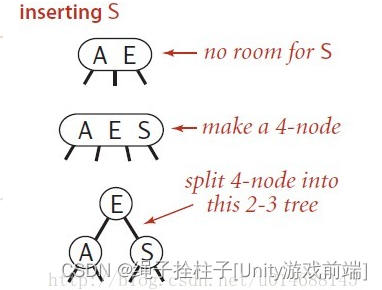
2.9 哈希查找
基本思想:
哈希表就是一种以 键-值(key-indexed) 存储数据的结构,我们只要输入待查找的值即key,即可查找到其对应的值。哈希的思路很简单,如果所有的键都是整数,那么就可以使用一个简单的无序数组来实现:将键作为索引,值即为其对应的值,这样就可以快速访问任意键的值。这是对于简单的键的情况,我们将其扩展到可以处理更加复杂的类型的键。
使用哈希查找有两个步骤:
- 使用哈希函数将被查找的键转换为数组的索引。在理想的情况下,不同的键会被转换为不同的索引值,但是在有些情况下我们需要处理多个键被哈希到同一个索引值的情况。
- 哈希查找的第二个步骤就是处理冲突,处理哈希碰撞冲突。有很多处理哈希碰撞冲突的方法,本文后面会介绍拉链法和线性探测法。
哈希表是一个在时间和空间上做出权衡的经典例子。如果没有内存限制,那么可以直接将键作为数组的索引。那么所有的查找时间复杂度为O(1);如果没有时间限制,那么我们可以使用无序数组并进行顺序查找,这样只需要很少的内存。哈希表使用了适度的时间和空间来在这两个极端之间找到了平衡。只需要调整哈希函数算法即可在时间和空间上做出取舍。
2.9.1 拉链法
将大小为M 的数组的每一个元素指向一个条链表,链表中的每一个节点都存储散列值为该索引的键值对。
c#算法实现:
namespace StructScript
{
/// <summary>
/// 哈希表的查找算法主要分为两步:
/// 第一步是用哈希函数将键转换为数组的一个索引,理想情况下不同的键都能转换为不同的索引值,但是实际上会有多个键哈希到到相同索引值上。
/// 因此,第二步就是处理碰撞冲突的过程。这里有两种处理碰撞冲突的方法:separate chaining(拉链法)和linear probing(线性探测法)。
/// 拉链法:
/// 将大小为M 的数组的每一个元素指向一个条链表,链表中的每一个节点都存储散列值为该索引的键值对,
/// </summary>
public class HashSearch1<T>
{
private int mCount;//散列表大小
private SequentialLinkedList<T>[] mHashArr;
//这个容量是为了测试方便,应根据填充数据,确定最接近且大于链表数组大小的一个素数
//并随着数据的添加,自动扩容
public HashSearch1() : this(997) { }
public HashSearch1(int m)
{
mCount = m;
mHashArr = new SequentialLinkedList<T>[m];
for (int i = 0; i < m; i++)
{
mHashArr[i] = new SequentialLinkedList<T>();
}
}
private int HashCode(T value)
{
return (value.GetHashCode() & 0x7fffffff) % mCount;
}
public void Add(T value)
{
//如果哈希出的索引一样,则依次添加到一个相同链表中
//添加的值,如果在链表中不存在,则依次在链表中添加新的数据
int hashCode = HashCode(value);
mHashArr[hashCode].Add(value);
}
public bool Contains(T value)
{
int hashCode = HashCode(value);
return mHashArr[hashCode].Contains(value);
}
}
}附上:拉链法使用的单链表C#代码
using System;
using System.Collections;
using System.Collections.Generic;
namespace StructScript
{
public class SequentialLinkedList<T> : IEnumerable<T>
{
private Node fakehead = new Node(default(T), null);
private Node mFirst;
private int mCount;
public SequentialLinkedList()
{
mFirst = null;
mCount = 0;
}
public void Add(T value)
{
if (value == null)
{
throw new ArgumentNullException();
}
if (!Contains(value))
{
//这里每添加一个新的项,往前依次添加,新增项作为新的表头
//如果往后添加的话,需要遍历所有节点,在最后的位置添加新的项
mFirst = new Node(value, mFirst);
mCount++;
}
}
public bool Remove(T value)
{
if (value == null)
{
throw new ArgumentNullException();
}
fakehead.next = mFirst;
for (Node prev = fakehead; prev.next != null; prev = prev.next)
{
if (value.Equals(prev.next.value))
{
prev.next = prev.next.next;
mFirst = fakehead.next;
mCount--;
return true;
}
}
return false;
}
public void Clear()
{
for (Node current = mFirst; current != null; current = current.next)
{
Node tempNode = current;
tempNode.next = null;
tempNode.value = default(T);
}
mFirst = null;
mCount = 0;
}
public bool Contains(T value)
{
if (value == null)
{
throw new ArgumentNullException();
}
for (Node current = mFirst; current != null; current = current.next)
{
if (value.Equals(current.value))
{
return true;
}
}
return false;
}
public IEnumerator<T> GetEnumerator()
{
return new Enumerator(this);
}
IEnumerator IEnumerable.GetEnumerator()
{
return new Enumerator(this);
}
public struct Enumerator : IEnumerator<T>
{
private SequentialLinkedList<T> list;
private int index;
private T current;
private Node node;
public Enumerator(SequentialLinkedList<T> list)
{
this.list = list;
index = 0;
current = default(T);
node = list.mFirst;
}
object IEnumerator.Current
{
get
{
if (index <= 0 || index > list.Count)
{
throw new IndexOutOfRangeException();
}
return current;
}
}
public T Current
{
get
{
if (index <= 0 || index > list.Count)
{
throw new IndexOutOfRangeException();
}
return current;
}
}
public void Dispose()
{
}
public bool MoveNext()
{
if (index >= 0 && index < list.Count)
{
if (node != null)
{
current = node.value;
node = node.next;
index++;
return true;
}
}
return false;
}
public void Reset()
{
index = 0;
current = default(T);
}
}
public int Count
{
get
{
return mCount;
}
}
private class Node
{
public T value;
public Node next;
public Node(T value, Node next)
{
this.value = value;
this.next = next;
}
}
}
}2.9.2 线性探测法
使用大小为M的数组来保存N个键值对,我们需要使用数组中的空位解决碰撞冲突。
当碰撞发生时,直接检查散列表中的下一个位置即将索引值加1。
线性探测虽然简单,但是有一些问题,它会导致同类哈希的聚集。在存入的时候存在冲突,在查找的时候冲突依然存在。
C#算法实现:
namespace StructScript
{
/// <summary>
/// 哈希表的查找算法主要分为两步:
/// 第一步是用哈希函数将键转换为数组的一个索引,理想情况下不同的键都能转换为不同的索引值,但是实际上会有多个键哈希到到相同索引值上。
/// 因此,第二步就是处理碰撞冲突的过程。这里有两种处理碰撞冲突的方法:separate chaining(拉链法)和linear probing(线性探测法)。
/// 线性探测法:
/// 使用大小为M的数组来保存N个键值对,我们需要使用数组中的空位解决碰撞冲突
/// 当碰撞发生时即一个键的散列值被另外一个键占用时,直接检查散列表中的下一个位置即将索引值加1
/// 线性探测虽然简单,但是有一些问题,它会导致同类哈希的聚集。在存入的时候存在冲突,在查找的时候冲突依然存在
/// </summary>
public class HashSearch2<T>
{
private int mCount = 16;//线性探测表的大小
private T[] mValues;
public HashSearch2()
{
mValues = new T[mCount];
}
private int HashCode(T value)
{
return (value.GetHashCode() & 0xFFFFFFF) % mCount;
}
public void Add(T value)
{
//当碰撞发生时即一个键的散列值被另外一个键占用时,直接检查散列表中的下一个位置即将索引值加1
for (int i = HashCode(value); mValues[i] != null; i = (i + 1) % mCount)
{
//如果和已有的key相等,则用新值覆盖
if (mValues[i].Equals(value))
{
mValues[i] = value;
return;
}
//插入
mValues[i] = value;
}
}
public bool Contains(T value)
{
//当碰撞发生时即一个键的散列值被另外一个键占用时,直接检查散列表中的下一个位置即将索引值加1
for (int i = HashCode(value); mValues[i] != null; i = (i + 1) % mCount)
{
if (value.Equals(mValues[i]))
{
return true;
}
}
return false;
}
}
}引用
算法 - 堆排序(C#)_LiveEveryDay的博客-CSDN博客
C# 算法之基数排序排序(非比较排序之三)_Ca_va的博客-CSDN博客_c#基数排序
C#数据结构-七大查找算法_鹅厂程序小哥的博客-CSDN博客_c# 查找
寒江独钓 对数据结构和算法,有很深的见地和理解。
倪升武的博客 对红黑树有很深的理解,本文的红黑树实现就是在此基础上实现的。